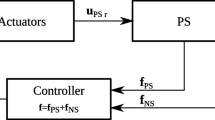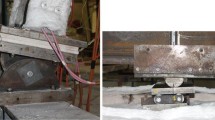Abstract
The world’s present and future challenges are impacted by the climate change, more and more limited access to resources along with the increase and aging of population. The engineering world will adapt to these challenges by developing new materials, new type of structural solutions, or new fire-based evaluation tools. The new developed materials or structural elements must be tested in order to validate and calibrate the existing or new fire-based evaluation tools, and hybrid fire testing is a new emerging promising technique. Generally, the fire tests are performed on single members, under constant mechanical boundary conditions, neglecting the action of the remainder structure. However, full-scale testing of full structural systems revealed different behaviors of the structural members, but the high cost makes the practice uncommon. Hybrid fire testing is keeping the advantage of testing only parts of the structure, but at the same time considering the effect of the remainder structure, thus reproducing the results of the full-scale testing. In the context of new emerging fire-based evaluation tools, i.e., machine learning has the potential to facilitate performance-based fire design of structures. This chapter conceptually describes the overlap of the hybrid fire testing methodology and the new fire-based evaluation tool, machine learning. A detailed description of hybrid fire testing method is presented along with a benchmark case study for exemplification purposes.
Access this chapter
Tax calculation will be finalised at checkout
Purchases are for personal use only
Similar content being viewed by others
References
Open System for Earthquake Engineering Simulation.
OpenFresco. Library Catalog: openfresco.berkeley.edu.
SFS C Studs | Drywall Steel Sections.
ABAQUS. ABAQUS Documentation, 2011. ZSCC: 0000003.
G. Abbiati, P. Covi, N. Tondini, O. Bursi, and B. Stojadinovic. A Real-Time Hybrid Fire Simulation Method Based on Dynamic Relaxation and Partitioned Time Integration. ASCE Journal of Engineering Mechanics, 2020.
G. Abbiati, S. Marelli, N. Tsokanas, B. Sudret, and B. Stojadinović. A global sensitivity analysis framework for hybrid simulation. Mechanical Systems and Signal Processing, 146:106997, January 2021.
Jean-Marc Franssen and Thomas Gernay. Modeling structures in fire with SAFIRⓇ: theoretical background and capabilities. JSFE, 8(3):300–323, September 2017.
Ian Goodfellow, Yoshua Bengio, and Aaron Courville. Deep learning. Adaptive computation and machine learning. The MIT Press, Cambridge, Massachusetts, 2016.
A. Gravouil and A Combescure. Multi-time-step explicit–implicit method for non-linear structural dynamics. Int. J. Numer. Methods, 50 (1):199–225, 2001.
ISO. Iso 834: Fire-resistance tests - Elements of building construction, 1975.
Mustesin Ali Khan, Liming Jiang, Katherine A. Cashell, and Asif Usmani. Analysis of restrained composite beams exposed to fire using a hybrid simulation approach. Engineering Structures, 172:956–966, October 2018.
M. Kiel. Entwicklung einer intelligenten Prüfmaschine für brandbeanspruchte Gesamttragwerke, 1989. ZSCC: 0000004.
M. Korzen, G. Magonette, and P Buchet. Mechanical loading of columns in fire tests by means of the substructuring method. Zeitschrift für Angewandte Mathematik und Mechanik, 79:S617–S618, 1999.
M. Korzen, J. Rodrigues, and A. Correia. Thermal restraint effects on the fire resistance of steel and composite steel and concrete columns. Appl. Struct. Fire Eng., pages 512–517, 2009.
B. Lattimer, J. Hodges, A. Lattimer, and Russia) International Seminar On Fire And Explosion Hazards (9; 2019; Saint Petersburg. Using Machine Learning in Physics-based Simulation of Fire. 2019.
Margaret McNamee, Brian Meacham, Patrick van Hees, Luke Bisby, W.K. Chow, Alexis Coppalle, Ritsu Dobashi, Bogdan Dlugogorski, Rita Fahy, Charles Fleischmann, Jason Floyd, Edwin R Galea, Michael Gollner, Tuula Hakkarainen, Anthony Hamins, Longhua Hu, Peter Johnson, Björn Karlsson, Bart Merci, Yoshifuni Ohmiya, Guillermo Rein, Arnaud Trouvé, Yi Wang, and Beth Weckman. IAFSS agenda 2030 for a fire safe world. Fire Safety Journal, 110:102889, December 2019.
Mehrdad Memari, Xuguang Wang, Hussam Mahmoud, and Oh-Sung Kwon. Hybrid Simulation of Small-Scale Steel Braced Frame Subjected to Fire and Fire Following Earthquake. J. Struct. Eng., 146(1):04019182, January 2020.
E. Mergny, G. Drion, and J.-M. Franssen. Stability in Hybrid Fire Testing Using PI Control. Exp Tech, May 2020.
E. Mergny, G. Drion, T. Gernay, and J.M. Franssen. A PI-controller for hybrid fire testing in a non-linear environment. In 10th International Conference on Structures in Fire, Belfast, 2018.
Hossein Mostafaei. Hybrid fire testing for assessing performance of structures in fire—Application. Fire Safety Journal, 56:30–38, February 2013.
Hossein Mostafaei. Hybrid fire testing for assessing performance of structures in fire—Methodology. Fire Safety Journal, 58:170–179, May 2013. ZSCC: 0000038.
M. Z. Naser. Autonomous Fire Resistance Evaluation. J. Struct. Eng., 146(6):04020103, June 2020.
M.Z. Naser. Fire resistance evaluation through artificial intelligence - A case for timber structures. Fire Safety Journal, 105:1–18, April 2019.
Gerald M. Newman, Jef T. Robinson, and Colin G. Bailey. Fire safe design: a new approach to multi-storey steel-framed buildings. Number 288 in SCI publication Fire and steel construction. Steel Construction Inst, Ascot, 2. ed edition, 2006.
Nicolas Pinoteau, Duc Toan Pham, Hong Hai Nguyen, and Romain Mège. Development of hybrid fire testing by real-time subdivision of physical and numerical substructures. JSFE, ahead-of-print(ahead-of-print), July 2020.
Alexander L. Pyayt, Ilya I. Mokhov, Bernhard Lang, Valeria V. Krzhizhanovskaya, and Robert J. Meijer. Machine Learning Methods For Environmental Monitoring And Flood Protection. June 2011. Publisher: Zenodo.
R. Qureshi and N. Elhami-Khorasani. Instantaneous stiffness correction for hybrid fire testing. In 10th International Conference on Structures in Fire, Belfast, 2018.
Ramla Karim Qureshi, Negar Elhami-Khorasani, and Thomas Gernay. Adaption of active boundary conditions in structural fire testing. JSFE, 10(4):504–528, December 2019.
I Rahmanian. Thermal and Mechanical Properties of Gypsum Boards and their Influences on Fire Resistance of Gypsum Board Based Systems. PhD thesis, University of Manchester, 2011.
S. Renard, J.-C. Mindeguia, F. Robert, S. Morel, and J.-M. Franssen. An Adaptive Controller for Hybrid Fire Testing. Exp Tech, June 2020.
F Robert, S Rimlinger, and C Collignon. PROMETHEE, FIRE RESISTANCE FACILITY TAKING INTO ACCOUNT THE SURROUNDING STRUCTURE. 1st International Workshop on Concrete Spalling Due to Fire Exposure, page 7, 2009.
Victor E. Saouma and Mettupalayam V. Sivaselvan, editors. Hybrid simulation: theory, implementation and applications. Balkema-proceedings and monographs in engineering, water, and earth sciences. Taylor & Francis, London; New York, 2008.
A. Sauca, E. Mergny, T. Gernay, and J.M. Franssen. A method for hybrid fire testing: Development, implementation and numerical application. In Martin Gillie and Yong Wang, editors, Applications of Fire Engineering, pages 225–234. CRC Press, September 2017.
Ana Sauca. Development and implementation of a methodology for hybrid fire testing applied to concrete structures with elastic boundary conditions. Doctoral Thesis, University of Liege, Liege, Belgium, 2017.
Sauca, A., Gernay, T., Robert, F., Tondini, N. and Franssen, J.-M. (2018), Hybrid fire testing: Discussion on stability and implementation of a new method in a virtual environment, Journal of Structural Fire Engineering, 9(4):319–341. https://doi.org/10.1108/JSFE-01-2017-0017
Ana Sauca, Nils Mortensen, Anders Drustrup, and Giuseppe Abbiati. Experimental validation of a hybrid fire testing framework based on dynamic relaxation. Fire Safety Journal, 121:103315, May 2021.
Ana Sauca, Chao Zhang, Artur Chernovsky, and Mina Seif. Communication framework for hybrid fire testing: Developments and applications in virtual and real environments. Fire Safety Journal, 111:102937, January 2020.
Andreas H Schellenberg, Stephen A Mahin, and Gregory L Fenves. Advanced Implementation of Hybrid Simulation. Pacific Earthquake Engineering Research Center PEER 2009/104, College of Engineering University of California, Berkeley, 2009.
P. Schulthess. Consolidated fire analysis—Coupled numerical simulation and physical testing for global structural fire analysis. Doctoral Thesis, ETH Zurich, 2019.
H. A. Schwarz. Gesammelte Mathematische Abhandlungen: Erster Band. Springer Berlin Heidelberg, Berlin, Heidelberg, 1890.
B. Taylor and C. Kuyatt. Guidelines for Evaluating and Expressing the Uncertainty of NIST Measurement Results. Technical Report NIST, Technical Note 1297, 1994.
N. Tondini, G. Abbiati, L. Posidente, and B. Stojadinovic. A static partitioned solver for hybrid fire testing. In 9th International Conference on Structures in Fire, Princeton, NJ, USA, 2016.
N. Tondini and J.-M. Franssen. IMPLEMENTATION OF A WEAK COUPLING APPROACH BETWEEN A CFD AND AN FE SOFTWARE FOR FIRES IN COMPARTMENT. In V International Conference on Computational Methods for Coupled Problems in Science and Engineering, pages 185–192, Ibiza, Spain, June 2013.
N. Tondini, V.L. Hoang, J.-F. Demonceau, and J.-M. Franssen. Experimental and numerical investigation of high-strength steel circular columns subjected to fire. Journal of Constructional Steel Research, 80:57–81, January 2013.
P. Underwood. Dynamic relaxation techniques: a review. Computational Methods for Transient Analysis, 1983.
Laura von Rueden, Sebastian Mayer, Rafet Sifa, Christian Bauckhage, and Jochen Garcke. Combining Machine Learning and Simulation to a Hybrid Modelling Approach: Current and Future Directions. In Michael R. Berthold, Ad Feelders, and Georg Krempl, editors, Advances in Intelligent Data Analysis XVIII, volume 12080, pages 548–560. Springer International Publishing, Cham, 2020.
Xuguang Wang, Robin E. Kim, Oh-Sung Kwon, and Inhwan Yeo. Hybrid Simulation Method for a Structure Subjected to Fire and Its Application to a Steel Frame. J. Struct. Eng., 144(8):04018118, August 2018.
Catherine A. Whyte, Kevin R. Mackie, and Bozidar Stojadinovic. Hybrid Simulation of Thermomechanical Structural Response. J. Struct. Eng., 142(2):04015107, February 2016.
Xilei Zhao, Ruggiero Lovreglio, and Daniel Nilsson. Modelling and interpreting pre-evacuation decision-making using machine learning. Automation in Construction, 113:103140, May 2020.
Author information
Authors and Affiliations
Corresponding author
Editor information
Editors and Affiliations
Rights and permissions
Copyright information
© 2022 Springer Nature Switzerland AG
About this chapter
Cite this chapter
Sauca, A. (2022). Hybrid Fire Testing: Past, Present and Future. In: Naser, M., Corbett, G. (eds) Handbook of Cognitive and Autonomous Systems for Fire Resilient Infrastructures. Springer, Cham. https://doi.org/10.1007/978-3-030-98685-8_12
Download citation
DOI: https://doi.org/10.1007/978-3-030-98685-8_12
Published:
Publisher Name: Springer, Cham
Print ISBN: 978-3-030-98684-1
Online ISBN: 978-3-030-98685-8
eBook Packages: Computer ScienceComputer Science (R0)




